Thirteen Ways of Looking at Alice in Wonderland in Film
 Tuesday, March 2, 2010 at 11:18AM
Tuesday, March 2, 2010 at 11:18AM Thirteen Ways of Looking at Alice in Wonderland in Film
A Curious List Created by Jan Susina,
author of The Place of Lewis Carroll in Children’s Literature.
Filmmakers have been intrigued by Alice in Wonderland almost since the beginning of motion pictures. The first Alice film was produced in England in 1903. Tim Burton’s Alice in Wonderland is the latest of film adaptations base on the Alice books, but how will it compare to previous versions of films inspired by Lewis Carroll’s classic books.
Jan Susina, author of The Place of Lewis Carroll in Children’s Literature (Routledge, 2009), has created a list of the top thirteen films that are either adaptations of Lewis Carroll’s Alice books, focus on the life of Carroll, or use Alice Adventures in Wonderland as a significant plot element.
The Alice books feature amazing spectacle, amusing dialogue, distinctive characters that have long appealed to many directors and actors. Carroll was strongly influenced by Victorian theatrical traditions, particularly the pantomime and wanted to adapt the books into a play. Carroll allows Henry Savile Clarke to adapt the two Alice books into Alice in Wonderland, a Dream Play of Children which was first performed in 1886. Carroll even contributed some of the lines.
The fantastical characters and landscapes of the Alice books encouraged film directors to use cutting-edge technology to transport viewers into the magical world. Just as Carroll was fascinated 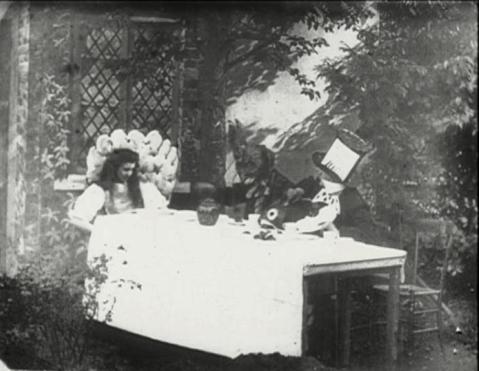 Mad-Hatter's Tea Party from 1903 Alice in Wonderland filmby the new medium of photography, directors of Alice films often use new and innovative techniques in their films adaptations. An Alice film was made as early as 1903.
Mad-Hatter's Tea Party from 1903 Alice in Wonderland filmby the new medium of photography, directors of Alice films often use new and innovative techniques in their films adaptations. An Alice film was made as early as 1903.
Just as the Alice books appeal to children and adults, so do films inspired by Alice in Wonderland. However, some films on this list are intended for adults, or older teens. Those films inappropriate for young children are noted.
For moviegoers anticipating Tim Burton’s Alice in Wonderland, the films in this list show how Carroll’s Alice books have inspired filmmakers around the world. One of the great strengths of the Alice books is how various directors have been able to create distinctive and original films based on the same text. Check out these films to see which one you think is the best adaptation. Unlike Carroll’s Alice books, which have never been out of print is their initial publications, some of these films are currently unavailable for sale. A few have just been recently released on DVD. Determined viewers should be able to find all of these films either on the secondhand market or on internet.
The films are listed in chronological order, rather than rank order. Some of are better than others, but each film is well worth watching. Enjoy.
1. Walt Disney’s Alice’s Wonderland (1923). This is the first of Walt Disney’s “Alice Comedies” series in which a young actress (Virginia Davis) enters into a wonderland of cartoons. When Disney moved to Hollywood he produced a series of short films from 1924-1927 which mixed live action with animation. This film and several of the other “Alice Comedies” are available on the Disney Rarities DVD, Disc 1. Although it is not part of these comedies, Disney did produce another short cartoon based on Through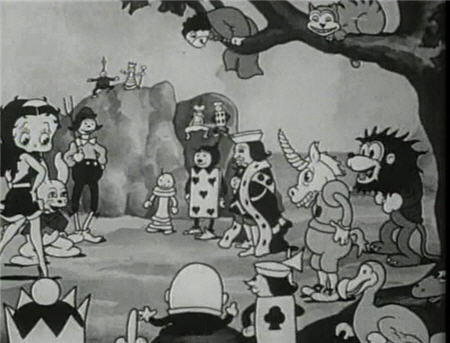 Betty in Blunderland the Looking-Glass called Thru the Mirror (1936). In this cartoon short , Mickey Mouse falls asleep after reading Alice Through the Looking Glass and enters into alternative world through a mirror very much like Wonderland.
Betty in Blunderland the Looking-Glass called Thru the Mirror (1936). In this cartoon short , Mickey Mouse falls asleep after reading Alice Through the Looking Glass and enters into alternative world through a mirror very much like Wonderland.
2. Dave Fleischer’s Betty in Blunderland (1933). Disney wasn’t the only animator who adapted Alice in Wonderland into cartoons. This short cartoon features Max and Dave Fleischer’s, famous curvy protagonist, Betty Boop, who enters an alternative world, borrowed from Wonderland and Looking-Glass, via a subway station. Betty Boop is no Alice, but it is entertaining.
3. Norman Z. McLeod’s Alice in Wonderland (1933). With a screenplay by Joseph L. Mankiewicz, this is a one of those star-filled films that Paramount produced in the 1930s and 1940s. The film features Charlotte Henry as Alice, with Gary Cooper at the White Knight, W.C. Fields as Humpty Dumpty, Edward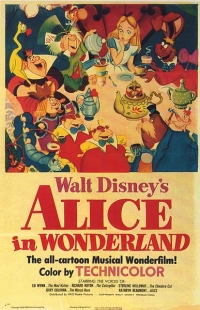 Everett Horton as the Mad Hatter and Sterling Holloway as the Frog. The release of this film discouraged Disney from making Alice in Wonderland as his first feature length cartoon. Instead, Disney chose to produce Snow White and the Seven Dwarves (1937) and the changed cinematic history.
Everett Horton as the Mad Hatter and Sterling Holloway as the Frog. The release of this film discouraged Disney from making Alice in Wonderland as his first feature length cartoon. Instead, Disney chose to produce Snow White and the Seven Dwarves (1937) and the changed cinematic history.
4. Victor Fleming’s The Wizard of Oz (1939). Some people might question why this famous film adaptation of L. Frank Baum’s book is on an Alice film list. But, Baum was deeply influenced by Carroll’s Wonderland. He was trying to create an American Alice in The Wonderful Wizard of Oz (1900). In this film, when Dorothy (Judy Garland) wakes up after her dream visit to Oz, she realizes the people in Kansas are versions of the folks he met in Oz. This is the same framing device Carroll used for Alice in Wonderland where Alice wakes from a dream that has been influenced by her surroundings.
5. Lou Bunin’s Alice in Wonderland (1948, France). An amazing adaptation that uses marionette animation. All the Wonderland characters are puppets except Alice, who is played by an adult. Before the tale begins, the film features Carroll interacting with Alice and even Queen Victoria. Disney was so threatened by this film that he tried, unsuccessfully, to stop its distribution of his film. Some of the sets were produced by Irving Block, famous for his Forbidden Planet (1956).
6. Walt Disney’s Alice in Wonderland (1951). Disney’s famous full-length animated cartoon combines the two Alice books. Classic Disney animation which memorable songs including “The Unbirthday Song.” While Kathryn Beaumont is good as the voice of Alice, Ed Wynn as the Mad Hatter, and Sterling Holloway as the Chershire Cat steal the show.
7. Jonathan Miller’s Alice in Wonderland (1967, BBC television). This film version is perhaps the most  Jonathan Miller's Alice in Wonderlandaccurate of the Victorian context for Alice. It features Peter Cook as the Mad Hatter, Michael Redgrave as the Caterpillar, and John Gielgud as the Mock Turtle, and Peter Sellers as the King. Miller’s adaption of Alice in Wonderland is on par with David Lean’s 1948 adaptation of Charles Dickens’ Oliver Twist.
Jonathan Miller's Alice in Wonderlandaccurate of the Victorian context for Alice. It features Peter Cook as the Mad Hatter, Michael Redgrave as the Caterpillar, and John Gielgud as the Mock Turtle, and Peter Sellers as the King. Miller’s adaption of Alice in Wonderland is on par with David Lean’s 1948 adaptation of Charles Dickens’ Oliver Twist.
8. Terry Gilliam’s Jabberwocky (1977). A Monty Python-esque film loosely based on the poem “Jabberwocky” from Carroll’s Through the Looking-Glass. The film features Michael Palin. Jabberwocky is medieval mayhem similar to Monty Python and the Holy Grail.
9. Jan Svankmajer’s Alice (1988, Czech). This is an astonishing, but terrifying stop-action adaptation of Alice in Wonderland. There is a fine line between spooky and creepy. I think Svankmajer crosses that line in this 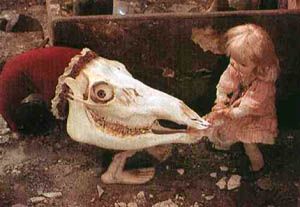 from Jan Svankmajer's Alicefilm. This edgy film is not for everyone, but it well worth watching for Alice enthusiasts who are teens and adults.
from Jan Svankmajer's Alicefilm. This edgy film is not for everyone, but it well worth watching for Alice enthusiasts who are teens and adults.
10. Gavin Millar’s Dreamchild (1992). This film is not an adaption of Alice, but it is a creative imagining of the relationship between Charles Dodgson and Alice Liddell, the young girl who inspired him to write the book. The film begins with 80-year-old Liddell visiting New York City for celebrations of the 100th anniversary of Carroll’s birth. Alice reflects on her childhood friendship with Dodgson/Carroll. The film features a sympathetic Ian Holm as Carroll and Jim Henson’s Muppets as the creatures in Wonderland.
11. Nick Willing’s Alice in Wonderland (1999, U.S. television). This is a star-studded, three-hour adaptation combines both Alice books. It features Tina Majorino as Alice, Whoopi Goldberg as the Cheshire Cat, Ben Kingsley as the Caterpillar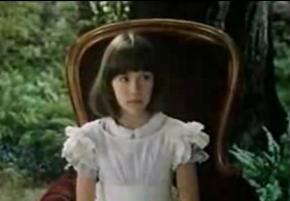 from Gavin Millar's Dreamchild, and Martin Short as the Mad Hatter. The stand out actors are Gene Wilder as the Mock Turtle and Peter Ustinov as the Walrus. The Victorian toy theater version of the Walrus and the Carpenter from Through the Looking-Glass is the highpoint of this film. It effectively frames the Alice books within a Victorian context. Characters that Alice meets in the real world reappear as altered characters in Wonderland, similar to The Wizard of Oz.
from Gavin Millar's Dreamchild, and Martin Short as the Mad Hatter. The stand out actors are Gene Wilder as the Mock Turtle and Peter Ustinov as the Walrus. The Victorian toy theater version of the Walrus and the Carpenter from Through the Looking-Glass is the highpoint of this film. It effectively frames the Alice books within a Victorian context. Characters that Alice meets in the real world reappear as altered characters in Wonderland, similar to The Wizard of Oz.
12. Neil Gaiman and Dave McKean’s MirrorMask (2005). Neil Gaiman is a great mimic and is able to update and revise classic texts. MirrorMask is goth-girl adaptation of the Alice books. This is a contemporary fantasy in which a teen-age girl, played by Stephanie Leonidas has her own adventures that eerily echo those of Carroll’s Alice.
13. Bob Shaye’s The Last Mimzy (2007). Based on Lewis Padgett’s “Mimsy were the Borogoves,” two children save the world from ecological destruction with the help of their stuffed white rabbit. The toy named Mimzy turns out to be a new form of artificial life using nanotechnology which has come back to warn the people of Earth of the forthcoming disaster. A complicated science fiction film that combines elements of E.T. and Alice.
For readers who would like a more comprehensive list of Alice film adaptations, they can read David Schaefer’s “Alice on the Screen” in Martin Gardner’s marvelous The Annotated Alice: The Definitive Edition (Norton, 2000).
If this list isn’t already quirky enough, on the horizon are two even more unusual film adaptations. Marilyn Manson, the creepy metal rocker, has an Alice film coming out called Phantasmagoria: The Visions of Lewis Carroll. Sarah Michelle Geller, of Buffy the Vampire fame, is the featured actor in the upcoming American McGee’s Alice, based on the popular, but violent, video game.

